For foundational context, please be sure to review our Landing Page.
Since their founding in 1997, TNTP has grown into a large, complex, and established organization. They’ve recently navigated challenging conversations about power and privilege, and Promise54 has worked alongside the organization throughout this journey. We’re sharing an overview of the successes and challenges TNTP has faced to offer honest stories about the complexity of realizing diversity, inclusion, and equity in a large organization.
Curious about what’s happened since the moment in time of this case study? Watch our webinar with leaders from TNTP and the co-authors of the cases here!
“TNTP’s mission is to end the injustice of educational inequality by providing excellent teachers to the students who need them most and by advancing policies and practices that ensure effective teaching in every classroom.”
“Our nation’s public schools will be thriving organizations that offer all children an excellent education.”

Focused on getting great teachers to more students. Teaching Fellows programs prepared talented people with deep content knowledge to teach in high-need schools and subjects
Founded as The New Teacher Project
Ran programs in partnership with major urban districts, including Baltimore, New Orleans, New York City, and Washington, D.C.

Published first policy reports and began helping school systems hire quality teachers earlier and staff schools more efficiently.
Provided hands-on consulting in two dozen districts, including Atlanta, Austin, Chicago, Los Angeles, Memphis, Philadelphia, and San Francisco.

Began working with state departments of education and charter management organizations.
Documented the systemic indifference to teacher effectiveness in The Widget Effect — and began working on better evaluations.

Working in more than 30 cities around the country.
Began exploring issues like school culture and leadership, and teacher retention and compensation.

“TNTP stands for so much more than new teachers. We are partners for change in public education, helping school systems achieve their goals for students.”
“We focus on three areas to ensure teachers succeed and students thrive: Rigorous academics, talented people, and supportive environments.”
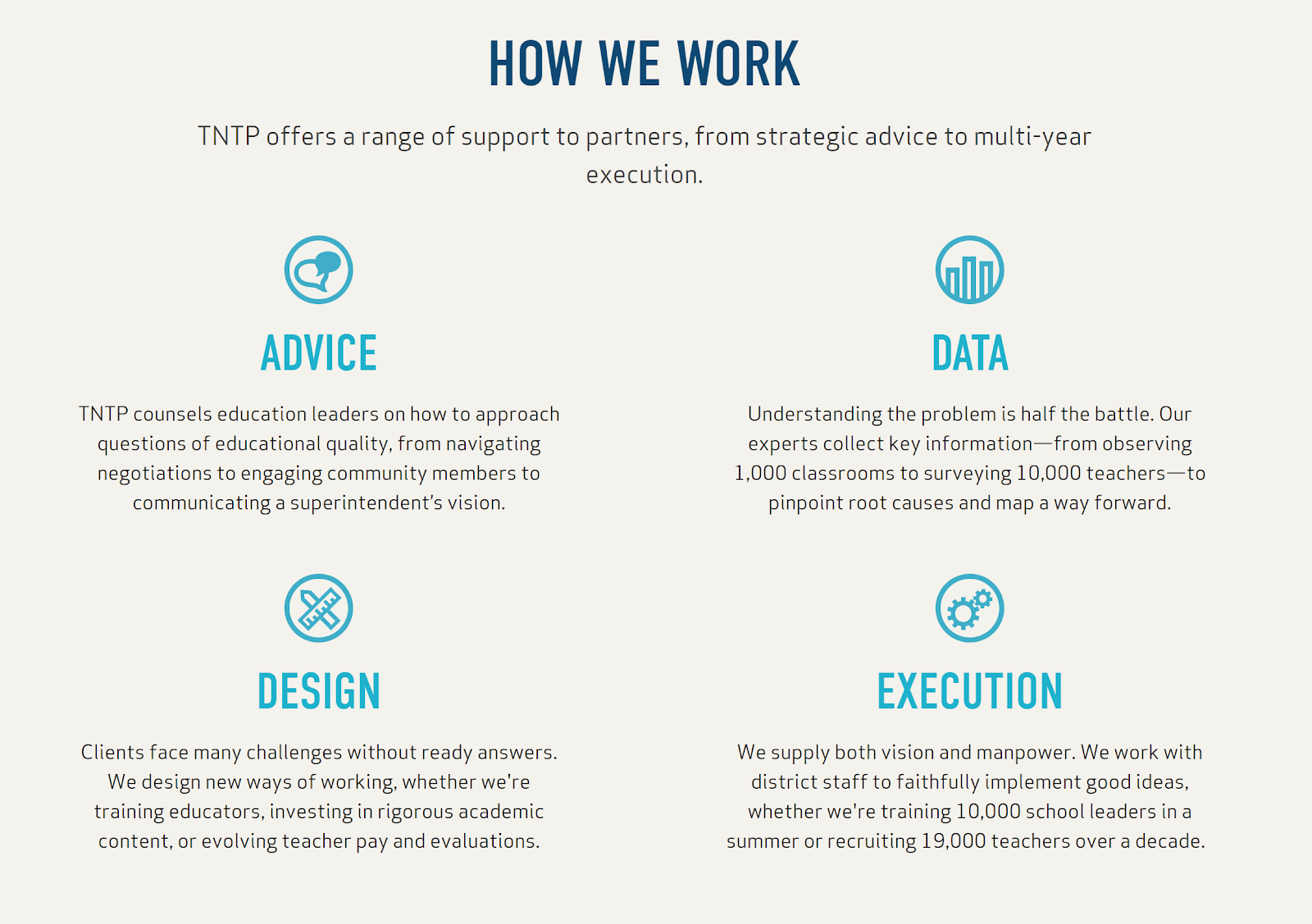
Graphic provided by TNTP
“We've supported more than 200 school systems nationwide, touching tens of thousands of educators and millions of students.”

Graphic provided by TNTP
In the wake of Hurricane Maria’s devastation of Puerto Rico in 2017, the island’s Department of Education reached out to TNTP, seeking insight on how to rebuild its Human Resources functions in new regional offices. TNTP agreed to offer pro bono support by sending team members to the island in person.
Initially, leadership reached out to TNTP’s Latinx affinity group for advice. The group had begun to recognize DEI at TNTP as largely a Black and white conversation, and voiced the need to elevate the experiences of Latinx staff. Leadership told the affinity group they’d follow up to engage the group on the plan and staffing for the Puerto Rico support initiative. But Latinx affinity group members later learned that, without the group’s consultation, a Spanish-speaking white staff member had been tapped to go. Not everyone in the affinity group was upset, but many staff were — especially those who identify as Puerto Rican.
TNTP Partner and one of the organization’s Latinx staff members, Leticia de la Vara, spoke up in a meeting with TNTP’s management team. The decision to send someone without the Latinx affinity group’s input, she told CEO Dan Weisberg, felt like disregard for cultural and historical considerations. It was a sign of the need for greater representation and inclusion of Latinx staff at TNTP.
So how did leadership respond? Dan halted the Puerto Rico project internally and externally with the client. He agreed to join the next Latinx affinity group call to listen, apologize, and figure out how to approach the situation differently. Moreover, he sent a written apology to the entire organization.
Staff remarked on how Dan’s response shifted the conversation:
“Leadership made a mistake. They communicated to the client that they were going to put the brakes on because of mistakes, and then they came back to the table and there was a messy process...leadership engaged [the Latinx affinity group] in the work, and it ended up working out. I don’t expect leadership to know everything, but that impressed me.”
—Ivan Nieves
Following this response, the Latinx affinity group was tasked with creating a better process for identifying staff to go to Puerto Rico, and experienced pressure to respond on a timeline the group members hadn’t set. Nonetheless, they developed robust selection criteria and modeled an inclusive, transparent, and accessible decision-making process. Ultimately, two Latinx affinity group members—Ivan Nieves, a Latinx Senior Manager who had attended high school in Puerto Rico, and Stephanie Zamorano, a Senior Manager as well, were chosen to go to the island.
“It was a seed for people to think about more than just what hard skills are needed for a project, and to be more considerate of the context — of who's there and who's impacted.”
—Leticia de la Vara
This was a major inflection point: It was the first time staff had heard leadership say aloud, “There are things we aren’t doing right, and we could do better” — and then immediately follow that acknowledgment with commitment and action.
However, the Puerto Rico moment was neither the starting point of TNTP’s DEI journey nor the first time the organization had experienced a misstep in diversity, inclusion, and equity. But this time, when members of the Latinx affinity group raised their voices, leadership was prepared to listen and respond accordingly. They weren’t conducting business as usual.
“Puerto Rico was different in how we responded to it. I know there were other experiences before I got to TNTP or while I was [here] where...something could be perceived as a slight against another race or another ethnic group, and we just moved on...Puerto Rico was different because we stopped, we paused — we said this doesn’t align with the organization that we want to be, so we have to do something different. And that came about because we had started to talk about DEI.”
—Tonya Horton
So what made this response possible? To answer that question, we looked back to 2015, when TNTP’s DEI conversations began in earnest.
We found the following central themes in our conversations with TNTP, each of which illustrate strengths as well as challenges in building a more diverse, inclusive, and equitable organizational culture.
Tequilla Brownie — now Executive Vice President, Strategy, Policy, and Community Coalitions — remembers a much more homogenous organization when she joined TNTP in 2013. Of over 40 Partners at the time, she was the only African American Partner. “I started in April and went to my first Partner meeting in June. Because we’re virtual and we weren’t talking about race and poverty in ed reform at that time, it was my first true awareness of how ‘white’ the space was,” Tequilla describes.
Tonya Horton, now Executive Vice President of Central Operations, had a similar experience when she first came to TNTP in 2014, and she describes how it felt to be a woman of color at a largely white organization.
“When I went to the Partner meeting, that was the first time that I was in the room with all of the Partners in the organization, and I was expecting that there were going to be some African American Partners ...that I just hadn’t met yet. And they just weren’t there.”
—Tonya Horton
At the time, the organization was separated into Performance Management — Tonya’s team, run by current TNTP CEO Dan Weisberg — and New Teacher Effectiveness. The racial diversity of the two teams looked very different, and it was clear to Tonya as she started asking questions that Dan was prioritizing DEI on his team in a different way.
When Dan eventually stepped into the CEO role, he — along with other leaders that recognized the importance of DEI to TNTP’s mission — demonstrated even greater intentionality around hiring a more diverse staff and setting clear goals for recruitment. Specifically, in an effort to increase diversity, leadership intentionally expanded beyond their traditional recruitment pools and networks, and decided they would not move forward with an interview unless the pool was racially diverse.
Having a white CEO who was prioritizing DEI was a big catalyst for change, but Dan was being bolstered and held accountable by those around him. Tequilla, Tonya, and many others on staff — many of them people of color at varying levels of positional authority — took the opportunity to agitate, educate, and push.
Tonya was proactive in early trainings, participating in sessions and advocating for difficult conversations that weren’t always happening. She advanced from her initial Partner role to a Vice President position and, in 2018, applied proposed to Dan and her manager that she would lead TNTP’s DEI work — using her past experience as a school leader and executive coach to better structure DEI initiatives. A short while later, Tonya interviewed and was selected to fill the recently vacated Executive Vice President for Talent and Culture role.
This hasn’t meant Tonya is solely in charge of owning and leading the work. Dan underscores the need to have full-team buy-in and shared responsibility for DEI because he acknowledges the emotional labor and burden involved when Black and Brown leaders are alone in ensuring white leadership accountability. People of color in leadership named one clear win: they weren’t alone in advocating for DEI at the senior level anymore.
“It can be burdensome to lead work on DEI...as a Black woman. You carry the weight of being both a leader and a staff [member] of color all the time. Having Tonya in place in her new role helped to shoulder some of that burden.”
—Tequilla Brownie
TNTP has found that cultural shifts require deep commitment from leadership — to set an example with one’s own actions and to cultivate shared responsibility across the organization.
“We looked like a really different organization 10 years ago...we had very little diversity. Seeing changes in our staff makeup demonstrates tremendous growth…[though] we still have a ways to go.”
—Anonymous Staff Member
An early step in TNTP making DEI an organizational imperative involved efforts to make the organization’s leadership less racially homogenous and more representative of the communities served. In 2015, after finding that most racial diversity existed below senior leadership, TNTP set a two-year goal to increase diversity at the senior level.
“In FY15 we set a two year goal to increase the diversity of our senior leadership to 30% staff of color and 25% African-American or Latinx. At the end of FY17, we met our staff of color goal and just missed our African-American/Latinx goal.”

Graphic provided by TNTP
TNTP began by shifting their promotion process for Partners and above from one that required manager nominations to an open application process. This more accessible system yielded a more diverse set of internal candidates and a more diverse group of people being promoted. After noticing significant demographic shifts in Partner+ promotions, TNTP then expanded this process to all staff and stepped back to think critically about the requisite skills for individual leadership positions. Adjusting both the selection process and the leadership competencies meant that promotion was no longer about who was in line for a role, but about who had the skills and desire. By the end of those two years, TNTP had made progress on diversifying leadership, falling just short of their goal for African American and Latinx individuals in senior roles.
Despite overall progress on diversifying the senior team, diversity gaps have been most pronounced for Latinx staff and leadership. In 2017, one-third of TNTP’s student community was Latinx, but that was not reflected on staff:
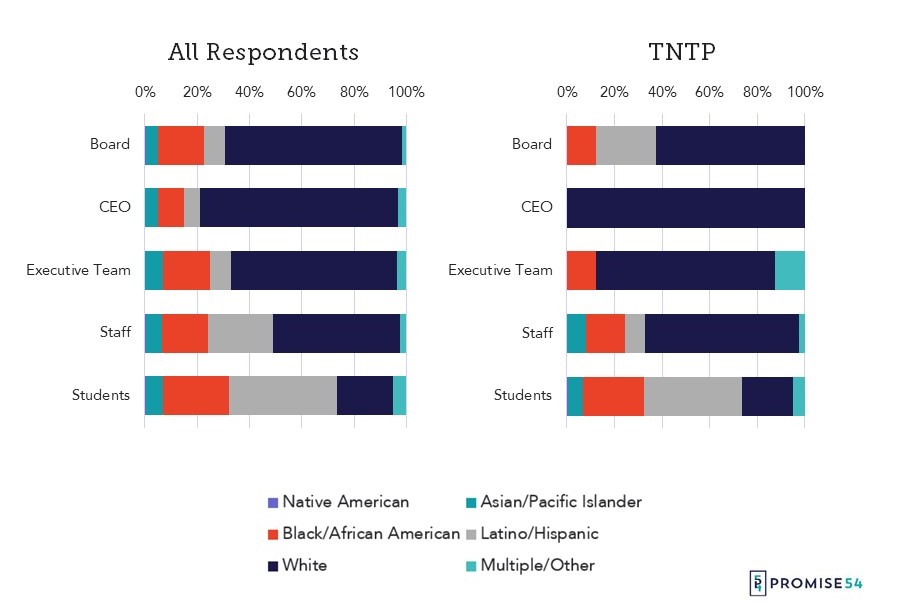
Dan reflects on this gap, explicitly noting that “[our] representation numbers around Latinx staff are terrible...If you look at the demographic of kids we serve, at least one-third of kids are Latinx. We can’t serve those communities well if we don’t have a similar cultural makeup.”
Explanations of the Latinx representation gap surfaced in interviews as some Latinx staff shared reservations about TNTP’s recruitment process. An increase in staff of color representation from 28% in FY15 to 40% in FY19 felt like a marked improvement, but those overall numbers masked the unique impact of TNTP’s screening standards and selection process on Latinx candidates. First, some Latinx staff believe that an overemphasis on perfect Standard American English could exclude communities for whom English is a second language.
“Weeding someone out just based on grammar without considering potential reasons or context for that doesn’t do us any favors in figuring out if someone is a good fit for a role. We want to make sure we’re not dismissing someone because of a very narrow rubric that doesn’t necessarily speak to the full context of their abilities and talents.”
—Leticia de la Vara
Moreover, multiple Latinx staff members shared that they personally faced socioeconomic barriers that prohibited them from going through the conventional hiring process.
“Clearly, the selection process is weeding people out...I say this having gone through [it]. It was a pretty intensive process. I went through multiple interviews, which is fine, but communities of color don’t always have the opportunity to wait for two to three months. And the people that do don’t always represent our community [from a socioeconomic standpoint]. This may dissuade people of color from participating, or if they want to, they can’t. I quit the process because I had to take an offer quickly. I appreciate the staff who came back and apologized to me and then recruited me from there, but the experience may be different for others.”
—Ivan Nieves
Latinx staff aren’t alone in seeking an improved recruitment process. On the latest Promise54 DEI Staff Experience Survey in December 2018, only half of the broader team agreed that recruiting efforts are designed to yield a diverse group of candidates. Despite incremental increases in the diversity of pipelines, candidate pools, and internal promotions, staff perceive that TNTP could do better.
TNTP began iterating on their initial focus on increased diversity, surfacing new questions about how to best support the now more diverse colleagues in the organization. Inclusion, Tonya reflected, needed to follow:
“As you get more diverse as an organization, you have to have systems and processes in place to make the people who you are bringing in feel like they are a part of the organization....That has been really important for us.”
—Tonya Horton
Early on, TNTP began working toward inclusion by bringing in external facilitators to design and implement internal DEI trainings, then bringing on internal full-time staff to drive deeper conversations and experiences around DEI-related topics. The team also focused on developing managers across the organization to drive inclusive environments on their teams in day-to-day interactions. These early efforts to promote inclusion were well-meaning, but weren’t coherent or self-sustaining yet. Challenges with inclusion persist at TNTP, and in December 2018, Latinx staff reported a disproportionately more negative experience than other racial and ethnic groups:

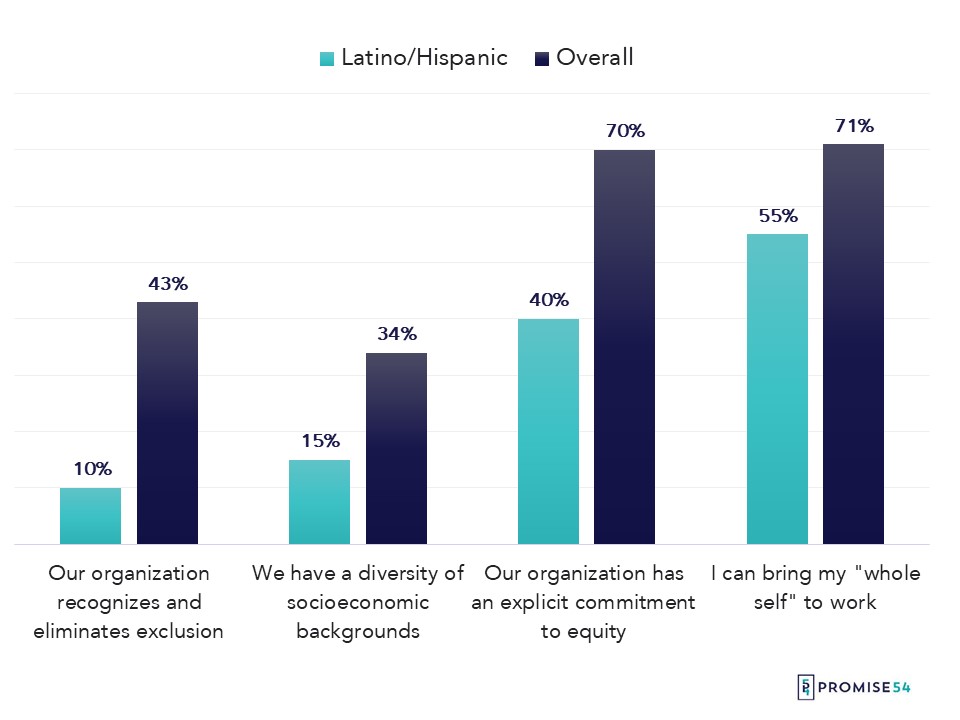
As TNTP strives to create a more inclusive culture for Latinx staff, the experiences of other staff members of color offer additional complexity. In our conversations with TNTP staff, we heard a need to nuance conversations about staff of color by teasing apart the experience of various racial and ethnic groups when examining DEI survey results. Asian American staff at TNTP specifically describe the risk that their voices aren’t heard when people of color are construed as a monolithic group. In response to the Promise54 DEI Staff Experience Survey question, “We have free and open expression of ideas, opinions and beliefs,” Black and Latinx staff agreement averaged in the 70s, compared with Asian American staff at 52%. Affinity groups are one place where individuals are speaking up.
“I didn’t speak up before when it came to DEI. Normally, I have no problem talking, and I talk a lot, but when it came to DEI conversations, I would shut down. I am half Asian, and I didn’t feel like I was a part of ‘black and brown’ and when we would have those [conversations], I would feel like ‘I can’t participate because I am seen as white.’ Finally, now, there’s an Asian staff affinity group, and I feel comfortable being a part of these conversations there.”
—Anonymous Staff Member
As TNTP works to create a more inclusive environment for Asian Americans and other staff of color, LGBTQ+ staff also report a greater need for equity, highlighting that the revamped career advancement processes don’t yet feel accessible for all.

Dan reflects on his next steps to better understand how inclusion and equity are playing out for Asian American and LGBTQ+ staff in particular:
“Looking at our engagement data...I saw that both LGBTQ and Asian staff had really low levels of engagement, and I shared with the organization that I haven’t invested in that enough to understand what might be driving the differences...One of my personal goals this year was to spend time with the LGBTQ affinity group, and with Asian American colleagues to get better insight as a leader.”
—Dan Weisberg
TNTP recognizes they haven’t yet created the inclusive environment they’re striving for, and they’re learning to shift behaviors to get there. In the interim, the team is beginning to address the discomfort, trauma, and burden disproportionately impacting staff with historically marginalized identities across the organization. Specifically, TNTP has recently begun to codify a restorative process for the organization, providing clear steps for staff members to follow in the event that one staff member causes emotional harm to another.
In 2018 — as Tonya took on the culture lead role — the need for definitions of diversity, inclusion, and equity emerged. TNTP’s understanding of the concepts needed to evolve, beginning with diversity.
“When we started, the definition [of diversity] was broader and people were like, ‘Really, what are you talking about?’ Then we defined it based on race because that is what we are prioritizing first. It’s not true that diversity is only about race, but it was our entry point.”
—Anonymous Staff Member
Around this time, TNTP brought in Promise54 to assess the organization’s current state of DEI, develop common language across the team, and draft a multi-year plan. After five previous years of earnest commitment, TNTP landed between Early Stage and Kindred on Promise54’s DEI Staff Experience Profile.
Survey results highlighted both bright spots and areas for growth on TNTP’s DEI work:


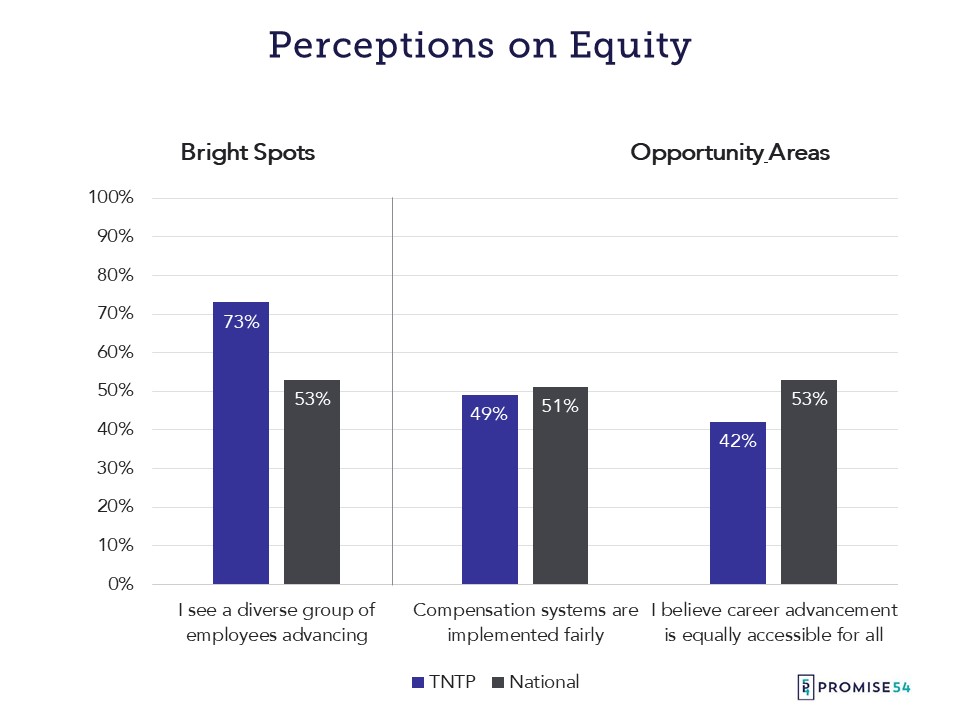
Following this assessment of TNTP’s current state, the organization began codifying their commitment to DEI by developing a belief statement and shared definitions. To do so, TNTP formed a DEI Working Group — comprised of staff across levels, identities, and functions — to develop initial drafts, share them with leadership and all staff for feedback, refine them, and then put them into motion.
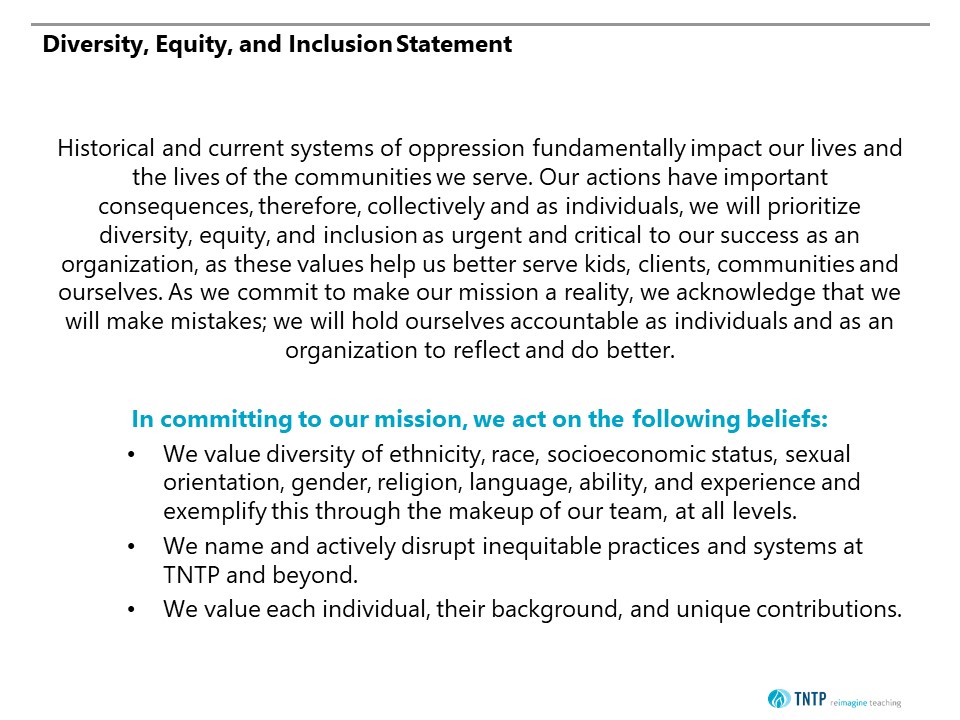

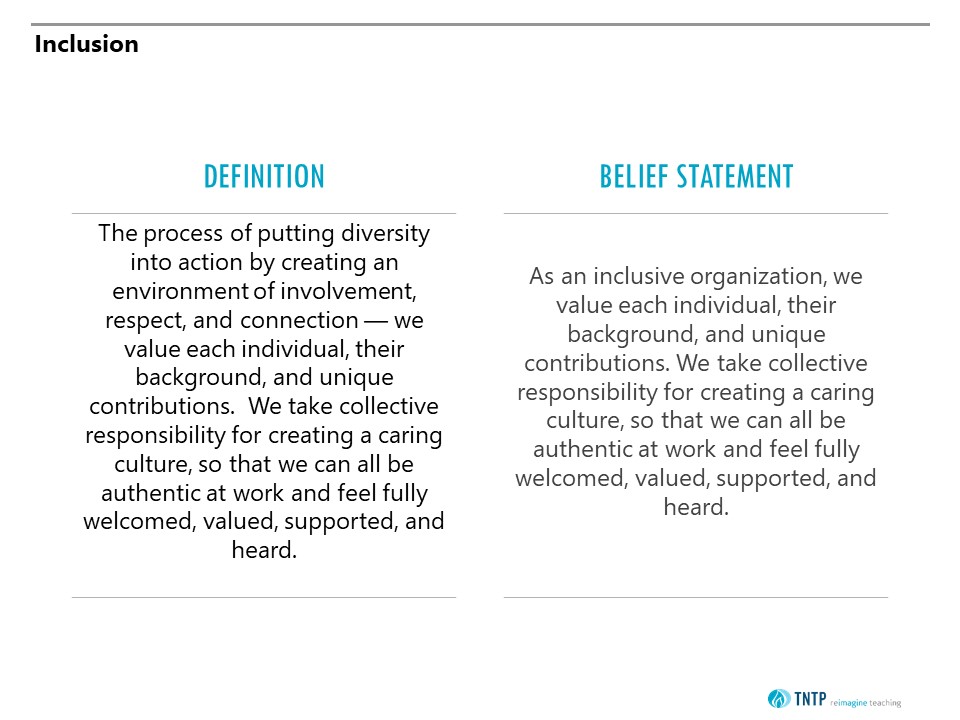
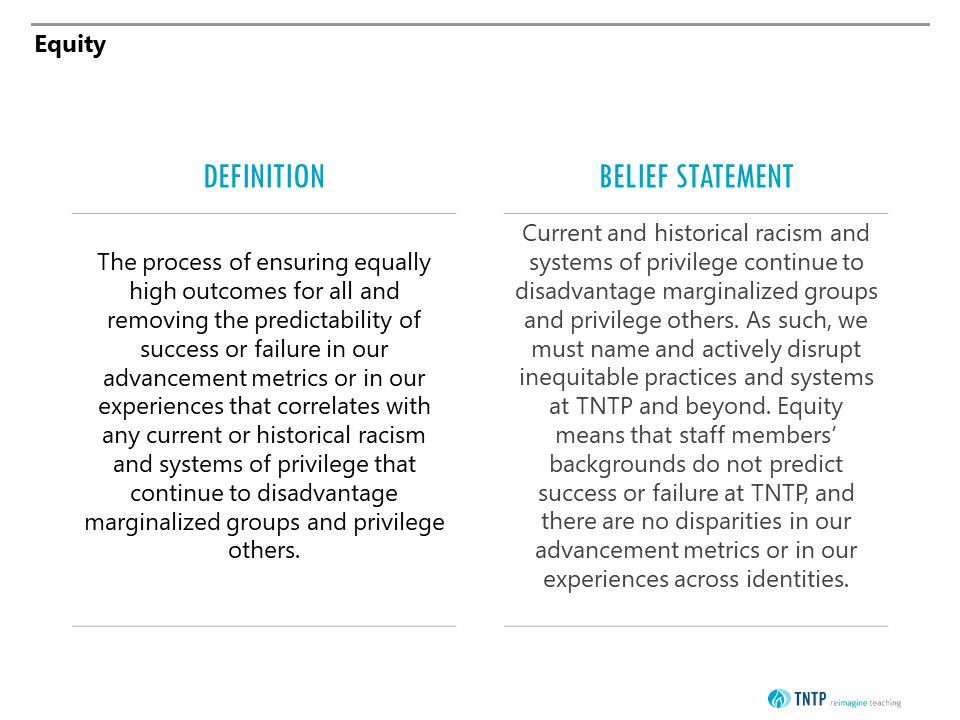
Graphics provided by TNTP
TNTP’s articulated beliefs and defined terms serve as just one part of the organizational change effort, grounding for a clear DEI strategy. Leadership, recognizing the lingering need to improve inclusion to better serve a more diverse staff, worked with the DEI Working Group to lay out a two-year, three-pronged strategy. Now, the team has aligned around the biggest opportunity areas, identified potential strategies to address them, prioritized the strategies, and thoughtfully sequenced them into a draft multi-year plan to solicit staff input before refining. Here’s a snapshot of the plan that emerged:
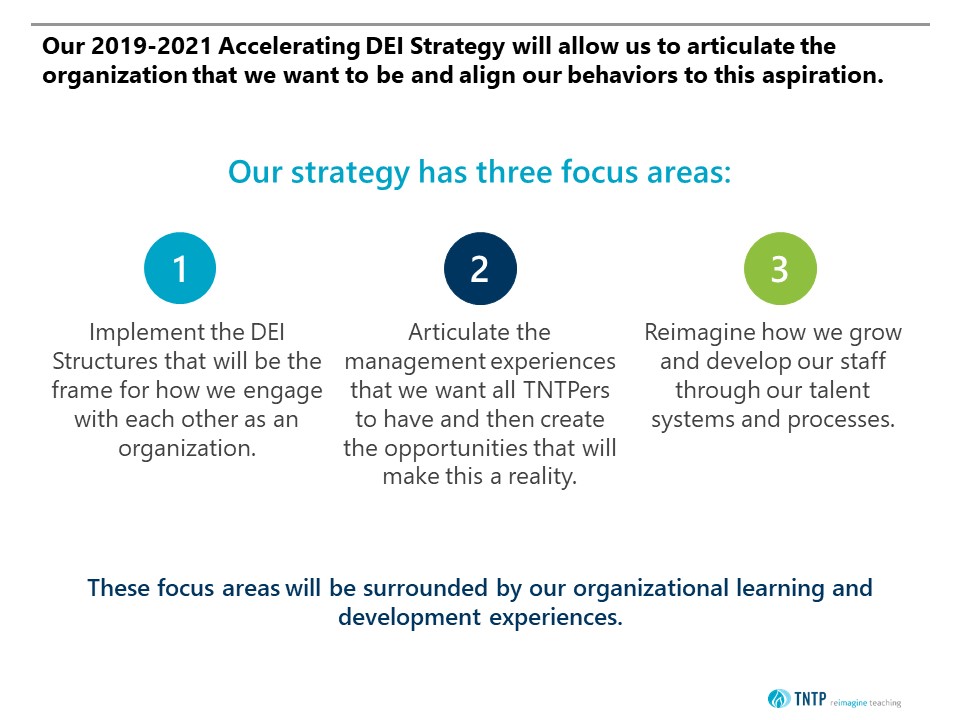
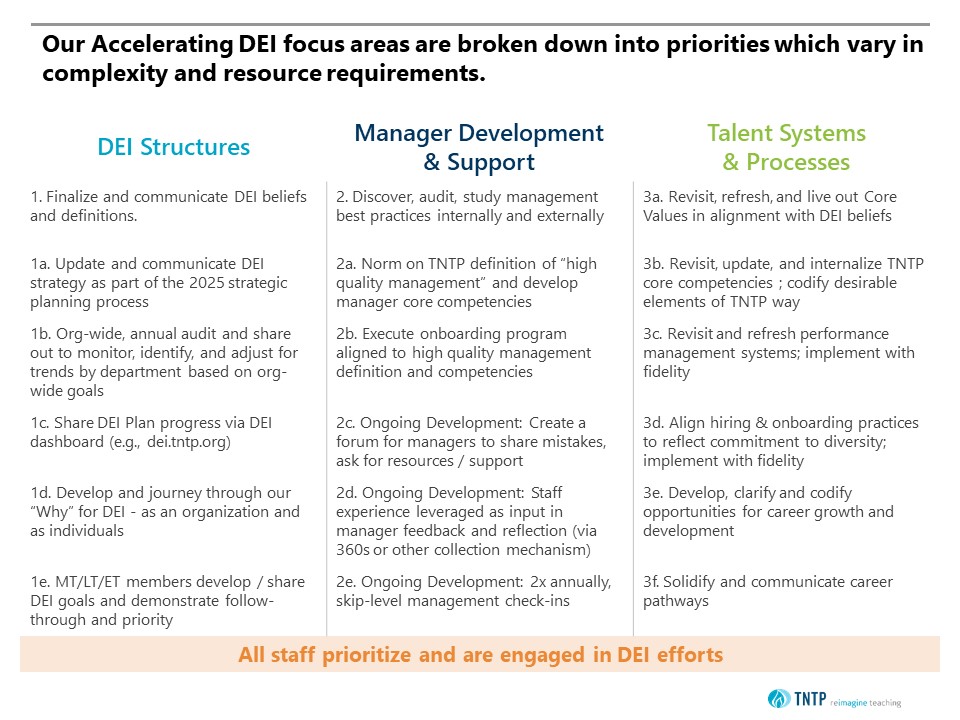
Graphics provided by TNTP
One important sign that the leadership team and working group have effectively invested multiple stakeholders across the organization: the overwhelming majority of staff are aware of the plan.

In 2016, TNTP hired an external organization to develop and facilitate trainings and conversations on DEI titled Conscious Inclusion. They’ve since further adapted the topics and materials and now facilitate these trainings internally. All new staff are required to participate in Conscious Inclusion within three months of their start date.
“This provides all staff with a foundation and common language on DEI, and it’s also an opportunity for us to share our story and our own DEI journey, and reflect on the importance and value of naming things when we see them.”
—Tonya Horton
This common language has facilitated an increase in conversations on difficult topics around race, identity, and privilege among staff members, reaching well beyond the Conscious Inclusion training.
“It’s less likely to be an agenda item and now more rooted in conversations about teamwork, and we want this. There is way more comfort in bringing forward our gaffes. People are much more honest now.”
—Dan Weisberg
These open conversations are taking place far more frequently among TNTP staff than at similar organizations.

Further, as TNTP staff discuss power, privilege, and explicit commitments to inclusion and equity, individual staff members describe their shifting behaviors and worldview:
“I came from the business world and slid right in with no problem at TNTP — I felt comfortable because I have that personality. What I think may have changed is that we have more opportunity for all staff to participate in the conversation...I would have said that I was aware before and there have been times when I said, ‘Holy shit, I live in a bubble,’ but now, I am developing a new awareness and this makes me think about how I react, how I think about things, how I talk to my team, and there are opportunities now to be vocal.”
—Anonymous Staff Member
At the same time, we heard individuals on the Diversity Leadership Council express frustration that DEI work stays on the level of conversation and doesn’t go further, particularly around microaggressions:
“If something happens to me, and I speak to someone about it, they say, ‘OK, let’s work with them and try to get them to be better’ — and I say, ‘Oh, well, this happened again,’ and they say, ‘Okay, well, I’ll talk to them again.’ So at what point are we going to stop saying ‘It’s okay that this happened to me’ and make change? There are no real visible consequences outside of a conversation that happens when people have negative experiences.”
—Kimberlee Logan
Staff beyond the Diversity Leadership Council expressed similar frustration, rating TNTP lower in response to the Promise54 DEI Staff Experience Survey question “Our organization recognizes and eliminates exclusion” relative to other inclusion index measures:

TNTP leadership rallied around this difference as an area for growth, noting that the question emphasizes recognition and elimination of exclusion. To begin moving from talk into action, leadership examined the feedback together at a leadership retreat, and decided to anchor in the mission to “walk the walk” of creating their desired inclusive culture.
As DEI conversations have increased in depth and frequency, and as the leadership team has explicitly committed to walking the walk, TNTP staff have increased their awareness and fluency around surfacing and resolving DEI issues. Now more than ever, staff are primed to notice and acknowledge gaps in diversity, inclusion, and equity at TNTP, and their standards and expectations for TNTP’s DEI work have thus risen. TNTP saw what they believe is evidence of this as staff’s perception of DEI initiative effectiveness and leadership’s prioritization of DEI dropped from 2018 to 2019.
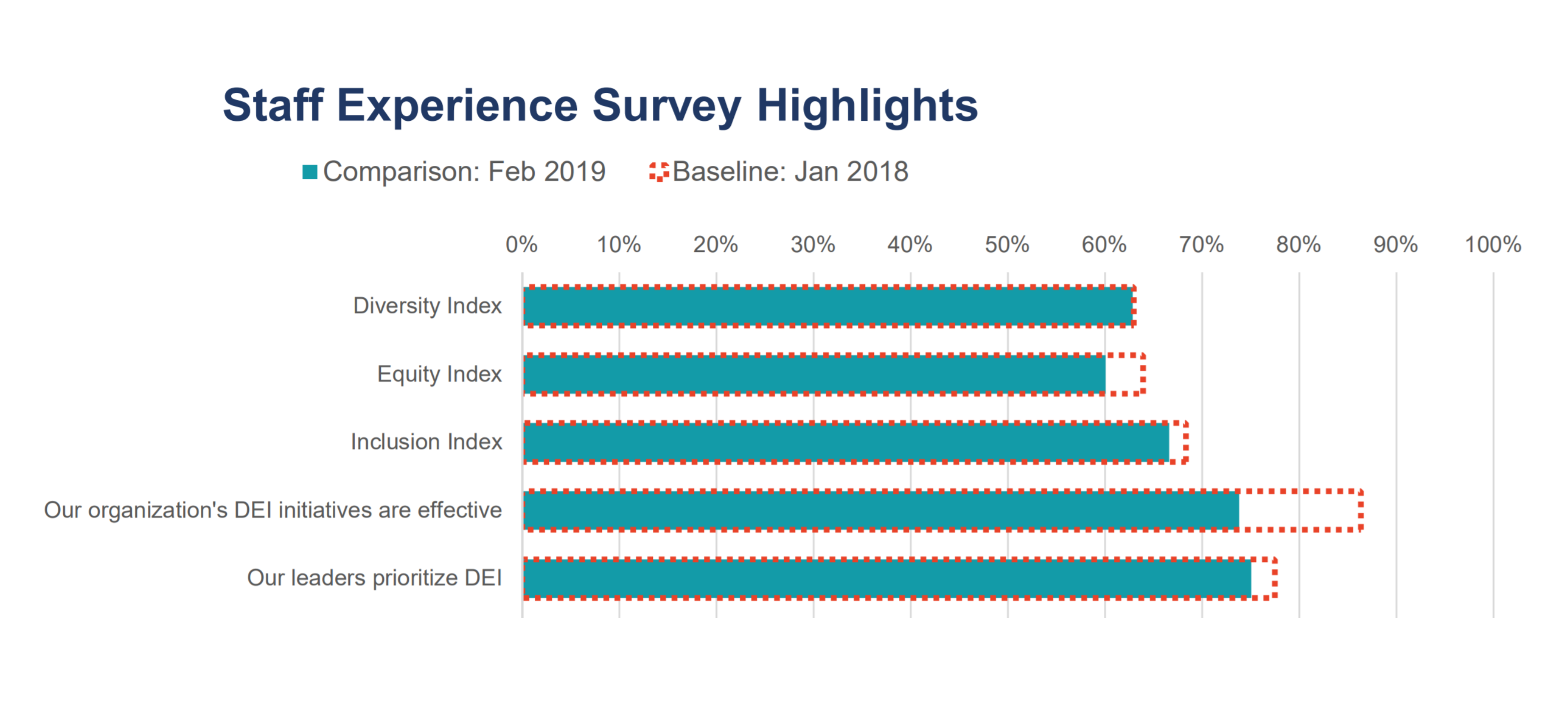
“As we have gotten our staff engagement surveys, we are seeing an uptick in people who see issues of race and bias...People are internalizing it, and that’s growth. It means that we have to keep at it for a while, and it’s a process.”
—Leticia de la Vara
One key positive sign is that staff see leadership’s willingness to recognize and prioritize their own growth:
“Leadership has been transparent in recognizing their place in DEI... and they’re willing to try to challenge [status quo] — they don’t know what it means, but [they’re] going to go in head-first. [It’s] ever-evolving, [and there’s] a commitment to listening.”
—Ivan Nieves
While TNTP has successfully identified and developed strategies to tackle some big challenges around representation, inclusion, and shared beliefs, one of their biggest barriers to true culture change has been what staff frequently referred to as “The TNTP Way.” Staff described it as shorthand for white-dominant culture norms, including background, skillset, work style, and ways of communicating.
“We still have a long road to get to where we want to be as an organization. Part of it is that we are very steeped in white-dominant culture norms. That is how we function as an organization, so trying to disrupt that takes time and it takes constant effort. And I don’t believe that it’s ever going to completely go away, but we have to build up our facility to interrupt it when we see it happen.”
—Tonya Horton
Tonya was first introduced to the concept of white-dominant culture norms while attending Promise54’s DEI Accelerator convening in spring 2017. For her, these concepts resonated deeply with much of what she saw and experienced at TNTP, and Tonya felt it was critical to bring this concept to the organization. These norms were shared as a pre-read and then served as the foundation for a Leadership Team retreat discussion. The concepts resonated so deeply there that they were subsequently shared with all staff, and many could see “The TNTP Way” reflected in these norms.
“It went ‘viral.’ There wasn’t really a strategy here on how to share these — everyone just got it; people felt like they finally had the language to name what this is. It was very much a ‘yes, that’s what we do; it doesn’t feel good but it’s true.’”
—Tonya Horton
Many staff believe that following “The TNTP Way” includes a worship of the written word, including the degree to which slide decks are still prioritized as proof of one’s knowledge and as the preferred way to disseminate information.
“When I joined the org...we had a very particular way of doing things...these crazy docs that had to be this way. ‘This is the TNTP way to do it’ has stuck with us for a long time, and we are just starting to scratch the surface of how to rid ourselves of that. We are talking about white [dominant] culture norms.”
—Emily Appel
Perfectionism and urgency were also elevated as elements of “The TNTP Way.”
“We also have a very proving-oriented culture — so we want to be perfect, we want to be right, we want to be sure that the deck looks a certain way, and all of those things have their benefits...and there are ways to still do high-quality work while we are allowing people to be their whole self, their authentic self. And it’s figuring out that balance for us.”
—Tonya Horton
“Anything related to DEI is complex. Sometimes people underestimate the complexity and...they want to move too quickly and they want to do this right externally, but it’s like, no, we have to get it right internally first.”
—Tamecca Chester
We also heard perceived either/or tensions between quality and diversity:
“Five years ago, I sat in an HR meeting where recruiting staff spoke about the need to hire more diverse staff (specifically Black staff) and to widen the recruitment field. While discussing how our initial filtering of applicants based on resumes and intro calls was ruling out too many candidates of color, one staff interjected with concern, ‘But we don’t want to lower our standards.’ No one commented on that or pushed back, but I felt it was very revealing, and it has stuck with me all of these years; that is, the mindset of the gatekeepers of hiring — changing our standards to something broader was ‘lowering.’”
—Karon Saulter
Finally, staff named the protection of white comfort as another illustration of “The TNTP Way.” In a training, a Black facilitator did not tiptoe around the concept of white fragility. The trainer was well-received by many Black staff members who found the approach refreshing, direct, authentic, and honest. While Black staff members applauded the way in which white comfort was not shielded, some white staff members responded critically to the trainer’s approach. At the sign of some initial rumblings in the session, Partner Christina Brown stood up and addressed the need to sit with discomfort internally in order to handle it when working in the field with clients.
“We can’t only work with people who think we are the greatest thing ever and have similar branding to what we do. We need to get into the practice of working with people who are different than us, not just for people who use the ‘right’ words internally, but think more broadly, expansively.”
—Christina Brown
While Christina — a woman of color — spoke up in the moment, other staff describe that white colleagues, in particular, need to embrace discomfort in order to truly dismantle dominant cultural norms and oppressive systems.
“White people get to be comfortable almost all of the time, and this has not changed in the organization...We have documentation as an organization that we want to dismantle white supremacy. That’s a bold statement, but when I hear it, I hear ‘blow stuff up, start from scratch.’ But really we dismantle in a way that still protects white comfort.”
—Shanequa Yates
Transforming ingrained cultural norms like the ones TNTP staff named as being part of “The TNTP Way” doesn’t happen overnight. The team has committed to the long-term work of transforming white-dominant culture norms through engagement, through having difficult and necessary conversations, and through holding themselves and one another accountable to interrupting and shifting behaviors in real time. As TNTP continues to work on this transformation, they’ve folded the topic of white-dominant culture norms into Conscious Inclusion training, leadership team retreats, and all-staff discussions.
TNTP leadership characterize their DEI journey as being “one of perpetual learning and growth,” and as they’ve leaned into conversations on inclusion and equity over the past few years, the team aims to match talk with action. Ultimately, TNTP wants to ensure that the organization is not replicating the very dynamics and systems of power they’re trying to interrupt for students and teachers across the country. This work is critical to their mission.
During FY20, TNTP will continue evolving by tackling the following projects through the lens of their shared DEI beliefs:
“We have sincerely, all across the organization, approached the work with a desire to learn and get better as individuals and as an organization. This doesn’t mean we did it well, but this is a prerequisite for making progress. People didn’t come in with the attitude that this was something to fix. People have approached the work in an impressive way, understanding that it requires a lot of reflection and soul searching, and many different ways of interaction. People know it’s not going to be an initiative that just Tonya owns, and people have approached it with lots of humility and openness, and have been willing to have some uncomfortable conversations and find a different way to interact.... We all continue to feel responsible for the work.”
—Dan Weisberg